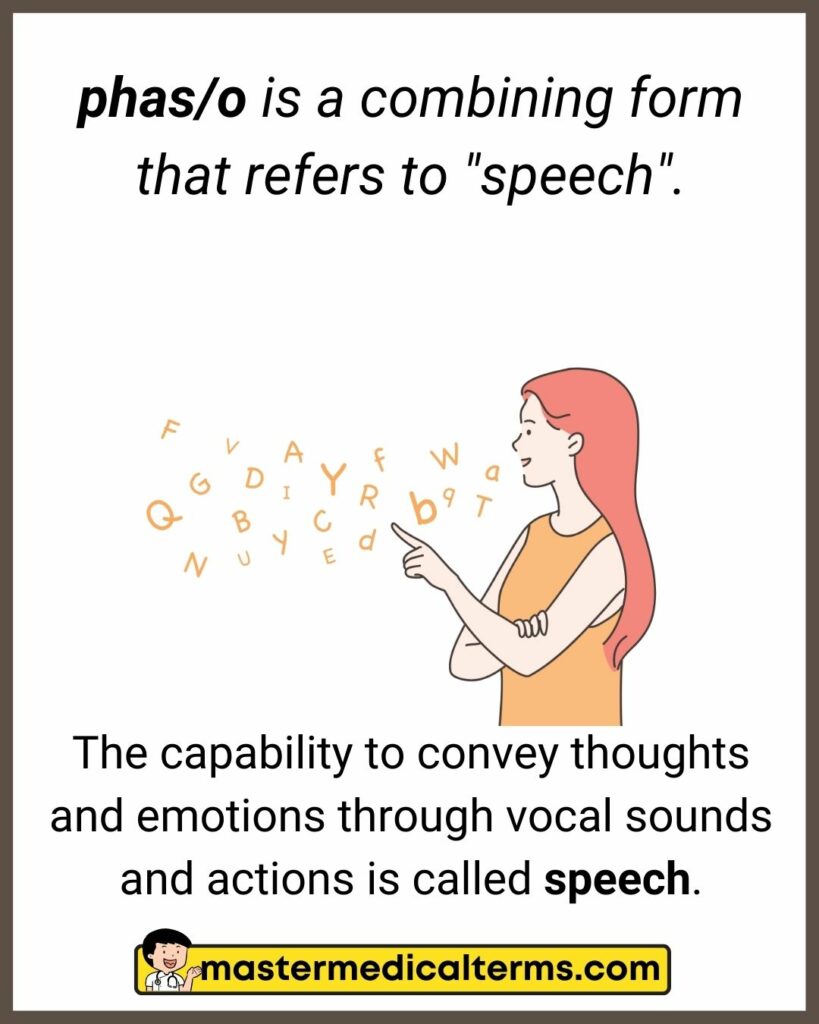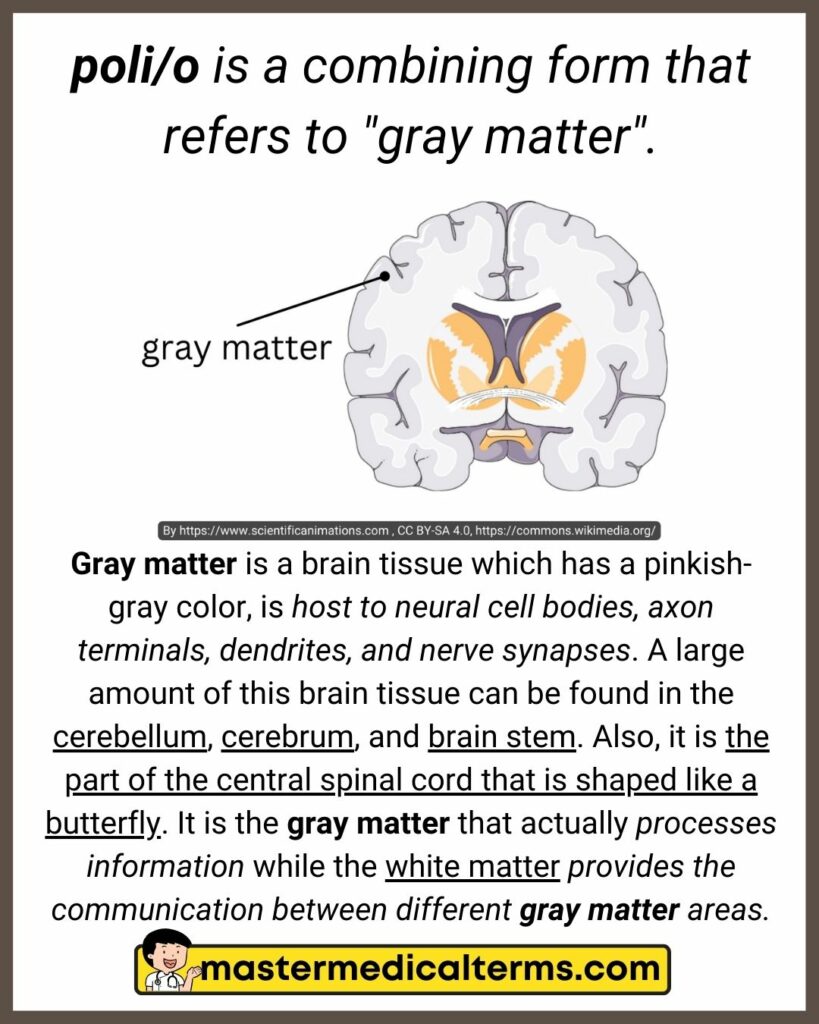By taking advantage of this flashcard review list, you will be able to become familiar with and better comprehend the root words and combining forms associated to the nervous system. Check out the quiz version of this flashcard if you want to see how much you remember.
#1 cephal/o
cephal/o is a combining form that refers to "head".
The head is the upper part of the body, the part above the neck where the eyes, nose, mouth, ears, brain, and the skull with its contents and coverings are located. It is joined to the spinal column by way of the first cervical vertebra, the atlas.
#2 cerebell/o
cerebell/o is a combining form that refers to "cerebellum".
The cerebellum ("little brain”) is a part of the brain situated at the back of the head, just above and behind the spinal cord. Cerebellum is an essential part of the brain that controls most physical movements and is mostly responsible for the control of muscles, including movement and balance. In addition, it helps to process language and memorize information.
#3 cerebr/o
#4 cortic /o
cortic/o is a combining form that refers to "cerebral cortex".
Located on top of the cerebrum, the cerebral cortex is its outer layer. In the cerebral cortex, there are three types of functional areas: motor, sensory, and association areas. Sensory areas receive sensory information from the thalamic nuclei, while motor areas control motor activities.
#5 dur/o
dur/o is a combining form that refers to "dura mater".
The dura mater is often called simply the dura. It is one of three layers of connective tissue that make up the meninges of the brain (pia, arachnoid, and dura). This layer surrounds and protects the brain and spinal cord, and it is the outermost of the three meninges.
#6 encephal/o
encephal/o is a combining form that refers to "brain".
The brain controls every function in our body, including thought, emotions, touch, motor skills, vision, breathing, temperature, hunger, and more. There are more than 100 billion nerves in the brain that are connected by trillions of synapses. The brain and the spinal cord that branch from it form the central nervous system.
#7 esthesi/o
#8 gangli/o, ganglion/o
gangli/o or ganglion/o is a combining form that refers to "ganglion".
A ganglion consists of several neuronal bodies in the peripheral nervous system (PNS). A ganglia is a structure that serves as a relay station for synaptic transmission between neurons. Information enters the ganglia, triggers the firing of neurons within the ganglia, and is then released out of the ganglia.
#9 gli/o
gli/o is a combining form that refers to "neuroglia".
The neuroglia, also known as glial cells or glia are a variety of cells that provide neuronal development, physiological support, and metabolic support. In the nervous system, they maintain homeostasis and immunity. The neuroglia are the supporting cells. While neurons are the body's communication network, neuroglia facilitate its functioning.
#10 medull/o
medull/o is a combining form that refers to "medulla oblongata".
In your brain, the medulla oblongata is located at the bottom. This is the place where your brain and spinal cord connect, serving as a key conduit for nerve signals. The medulla oblongata transmits signals from the spinal cord to the higher parts of the brain and controls autonomic functions, such as heartbeat and respiration.
#11 mening/o, meningi/o
mening/o or meningi/o is a combining form that refers to "meninges".
The meninges are three layers of membranes covering and protecting the brain and spinal cord (the central nervous system). The dura mater is the outer layer, closest to the skull. The arachnoid mater is the middle layer. The pia mater is the inner layer, located closest to brain tissue.
#12 myel/o
myel/o is a combining form that refers to "spinal cord".
The spinal cord is a thin, long tube-like structure made up of nervous tissue, connecting from the brainstem to the lumbar region (backbone). Spinal cord functions include sending motor commands from the brain to the body, sending sensory information from the body to the brain, and coordinating reflexes.
#13 narc/o
#14 neur/o, neur/i
neur/o or neur/i is a combining form that refers to "nervous system" or "nerve".
Nervous system components include the brain, spinal cord, and nerve fibers. This system is responsible for sending and receiving messages both between the brain and the body. All body functions are managed by the brain. Down the back, the spinal cord extends from the brain.
Examples of Medical Terms Containing neur/o or neur/i
Neuron: neur ( "nerve") + -on ( "small unit")
Definition: A nerve cell that carries electrical signals through the body.
Neurotransmitter: neur/o ( "nerve") + transmit ( "to send" or "to convey") + -er ( "one that does the action").
Definition: A substance that carries signals between neurons.
Neuropathy: neur/o ( "nerve") + -pathy ( "disease").
Definition: A disease or disorder of the nervous system.
Neurology: neur/o ( "nerve") + -logy ( "study of")
Definition: The study of the nervous system and its disorders.
Neuritis: neur ( "nerve") + -itis ( "inflammation")
Definition: Inflammation of a nerve, which can cause pain and numbness.
Neurosurgery: neur/o ( "nerve") + surgery ( "treatment by operation")
Definition: Surgery that deals with the nervous system.
Neurotoxicity: neur/o ( "nerve") + toxic ( "poison") + -ity ( "state or condition")
Definition: Poisoning of the nervous system caused by certain drugs or toxins.
Neuromuscular: neur/o ( "nerve") + muscul ( " muscle") + -ar ( "pertaining to")
Definition: Relating to the interaction between the nervous system and muscle.
Neuroma: neur ( "nerve") + -oma ( "tumor")
Definition: A benign tumor that develops on a nerve.
Neuronal: neur ("nerve") + -on ("small unit) + -al ( "pertaining to")
Definition: Relating to neurons and their function.
Neuromodulator: neur/o ( "nerve") + modul ( "to regulate") + -ator ( "agent")
Definition: A substance that regulates the activity of neurons.
Neuroplasticity: neur/o ( "nerve") + plast ( "able to be shaped or formed" ) + -icity ( "state or condition" )
Definition: The ability of the nervous system to change in response to experience or injury.
Neurogenesis: neur/o ( "nerve") + genesis ( "origin").
Definition: The origin of new neurons in the nervous system.
Neuropathic: neur/o ( "nerve") + -pathic ( "disease" or "suffering")
Definition: Relating to a disorder or pain caused by problems with the nerves or nervous system.
#15 phas/o
#16 poli/o
poli/o is a combining form that refers to "gray matter".
Gray matter is a brain tissue which has a pinkish-gray color, is host to neural cell bodies, axon terminals, dendrites, and nerve synapses. A large amount of this brain tissue can be found in the cerebellum, cerebrum, and brain stem. Also, it is the part of the central spinal cord that is shaped like a butterfly. It is the gray matter that actually processes information while the white matter provides the communication between different gray matter areas.
#17 psych/o, ment/o
#18 radic/o, radicul/o, rhiz/o
radic/o, radicul/o or rhiz/o is a combining form that refers to "nerve root".
A nerve root is a branch that is located at the end of a spinal nerve, cranial nerve, or spinal nerve. Nerve roots come in two types: cranial and spinal. Movement and feeling are stimulated by spinal nerve roots. Cranial nerves send electrical signals from your brain to your face, neck, and torso. Senses such as taste, smell, hearing, and touch are also mediated by the cranial nerves.
#19 somn/o, somn/i
somn/o or somn/i is a combining form that refers to "sleep".
Sleep is a naturally recurring cycle of mind and body. It involves altered consciousness, reduced sensory activity, decreased muscle activity, and the inhibition of almost all voluntary muscles during rapid eye movement sleep. As a result of sleep, the body and mind are reenergized, allowing a person to wake up refreshed and alert.
#20 thalam/o
thalam/o is a combining form that refers to "thalamus".
The thalamus is a thick mass of gray matter situated in the back part of the diencephalon (part of the forebrain). The thalamus is the body's information relay center. Information from the senses (except smell) must be processed by the thalamus before it can be interpreted by the cerebral cortex.























